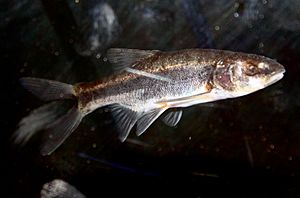Little Colorado spinedace facts for kids
Quick facts for kids Little Colorado spinedace |
|
|---|---|
 |
|
| Conservation status | |
| Scientific classification | |
| Synonyms | |
|
The Little Colorado spinedace (Lepidomeda vittata) is a type of ray-finned fish. It belongs to the minnow family, called Cyprinidae. This fish lives only in Arizona, in the United States.
Contents
What Does It Look Like?
The Little Colorado spinedace is a small fish. It is usually less than 10 centimeters (about 4 inches) long. It has many scales along its side, usually more than 90.
Fins and Teeth
The fish has a strong second spine in its dorsal fin. This fin is on its back and stands up quite high. It also has eight (sometimes nine) rays in its anal fin, which is on its belly. Inside its throat, it has two rows of special teeth called pharyngeal teeth.
Colors of the Spinedace
The sides of the Little Colorado spinedace are usually shiny and silver. Its back and upper side can be a bluish or lead gray color. Sometimes, it has dark spots on its sides. Its belly is often white.
When it's time to breed, the male spinedace changes color. The bases of its paired fins (fins that come in a set of two) turn watery-yellow, orange, or red-orange. Other parts of its fins stay clear. Some parts of its belly also become watery-yellow.
Where Does It Live?
The Little Colorado spinedace lives only in the Little Colorado River and its northern branches. These rivers flow through Coconino, Navajo, and Apache Counties in Arizona. This fish is endemic to this area, meaning it's found nowhere else naturally.
Past and Present Homes
Historically, the spinedace lived in similar areas. It might have also lived in the Zuni River watershed, south of Gallup, New Mexico. However, it is no longer found in Silver Creek and its smaller streams. This means it is now extirpated (locally extinct) from those places.
Today, you can find populations of spinedace in four main areas in Arizona. These include the main part of the Little Colorado River, Nutrioso Creek, Clear Creek, and Chevelon Creek.
What Kind of Habitat Does It Prefer?
The Little Colorado spinedace likes water that is not too deep. It is often found in water about 0.6 meters (about 2 feet) deep. It can live in water from 0.16 to 1.3 meters (about 6 inches to 4 feet) deep.
Water Flow and Bottom
These fish prefer water that moves slowly to moderately. They like to swim over bottoms made of fine gravel. They usually stay away from very deep, shady pools. They also avoid shallow, open areas where there isn't much cover.
Ideal Conditions
The spinedace prefers pools that are not shaded. They like to have rocks or undercut banks (where the river bank hangs over the water) to hide under. The water temperature where they live is usually between 14 and 26 degrees Celsius (57 to 79 degrees Fahrenheit). Young spinedace, called "young of the year," are often found in fast-moving, bumpy parts of the river called riffles. These riffles are usually 10 to 25 centimeters (4 to 10 inches) deep.
How Are Its Populations Changing?
The number of Little Colorado spinedace can change a lot from year to year. These changes often depend on how much rain there is. For example, during times of drought (when there is not much rain), their numbers might go down. When there is more rain, their numbers might go up.
Why Are Numbers Declining?
Even with these natural changes, the overall number of spinedace is thought to be decreasing. This is happening because their habitat is changing. Rivers might have less water flowing in them. Also, new types of fish have been brought into their rivers. These new fish can compete with the spinedace for food and space. They might also eat the spinedace.
What Harms the Spinedace?
Several things can limit the number of Little Colorado spinedace. Building roads near rivers can harm their habitat. Cutting down trees (timber harvest) can also affect the streams. Removing gravel from streams is another problem. Sometimes, chemicals are used to treat streams, which can hurt the fish.
Other Dangers
Other concerns include less water flowing in the streams. Building dams or other structures that hold back water can also be harmful. When new fish are introduced, they can compete with the spinedace. They might also eat the spinedace. For example, rainbow trout are thought to eat many young spinedace. This can greatly affect where the spinedace can live and how well they survive.
See also
 In Spanish: Lepidomeda vittata para niños
In Spanish: Lepidomeda vittata para niños


